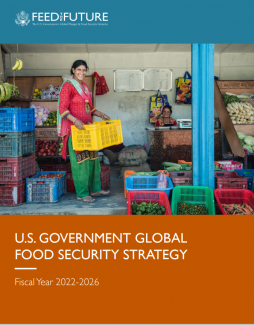This Global Food Security Strategy presents an integrated whole-of-government strategy and agency-specific implementation plans as required by the Global Food Security Act of 2016.
The U.S. Government’s Global Food Security Strategy is an integrated whole-of-government approach that aims to end global hunger, poverty, and malnutrition through the Feed the Future initiative. The updated strategy, launched in the fall of 2021, builds from the previous five-year strategy that was developed under the Global Food Security Act of 2016. The first strategy created a blueprint to effectively implement Feed the Future, the Sustainable Development Goals (SDGs), and the 2030 Agenda. Guided by the Global Food Security Strategy, Feed the Future proved that progress ending hunger is possible.
Since its inception in 2010, Feed the Future helped 23.4 million more people lift themselves out of extreme poverty, 3.4 million more children who are not stunted, and 5.2 million more families live free from hunger.
However, today’s volatile environment demands that our strategy adapt to a rapidly changing global context. Building off the latest evidence and insights from communities Feed the Future works with—and lessons learned from the first strategy— the Feed the Future interagency refreshed the strategy to address crises that threaten to undermine global food security progress. Through this strategy, we aim to contribute toward a 20 percent reduction in poverty and stunting in the areas where we work between 2022-2026 by partnering with foreign governments, the private sector, civil society, implementers, and the research community.
This updated strategy serves as a vigorous response to the challenges of our moment, including COVID-19, conflict, inequity, and climate change. Feed the Future’s predominant goal and vision is to sustainably reduce global poverty, hunger, and malnutrition across three interconnected objectives:
- Inclusive and sustainable agriculture-led economic growth: Foster growth in the agricultural sector that increases access and availability to nutritious food and creates sustainable entrepreneurship opportunities.
- Strengthened resilience among people and systems: Increase efforts to sustainably lift communities from entrenched poverty and combat intense shocks and stresses.
- A well-nourished population, especially among women and children: Promote nutrition, especially during the 1,000 days from pregnancy to a child’s second birthday.
The updated strategy highlights five new or elevated priority areas of emphasis and action. Together, these position Feed the Future to successfully adjust and pivot in a constantly changing global landscape.
- Equity and Inclusion: We will collaborate with local partners to address challenges to inclusion and intentionally engage all who can contribute to and benefit from inclusive growth. If we do not intentionally include, we unintentionally exclude.
- An Ambitious Approach to Climate Change: We will address short- and long-term effects of climate change that can undermine agricultural practices, labor, and livestock, prioritizing locally led solutions.
- Proactively Countering the COVID-19 Pandemic’s Long-Term Effects: We will implement practices that counter the negative impacts of the pandemic, disrupt food systems, and shut down economies. Working Across the Entire Food System: We will take into account the many integrated parts of food’s journey from cultivation to consumption to work across the food system, not just in particular value chains or market systems.
- Integration of Conflict Mitigation, Peacebuilding, and Social Cohesion: We will integrate social, political, and local dynamics within programming to improve food security and nutrition outcomes and build resilience.
- Working Across the Entire Food System: We will take into account the many integrated parts of food’s journey from cultivation to consumption to work across the food system, not just in particular value chains or market systems.
To measure progress and remain accountable to the public, U.S. Government partners commit to strengthening our rigorous monitoring, evaluation, and learning (MEL) approach, which includes a common results framework; standard performance indicators; an evaluation approach using impact and performance evaluations’ a common learning framework that prioritizes key evidence gaps; and a focus on strengthening target country data systems and processes.

